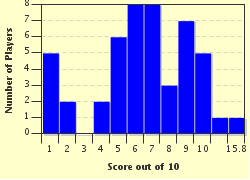Quiz Answer Key and Fun Facts
1. This British light tank was produced in limited numbers and were used in the Madagascar campaign (1942). Some were supplied to the Soviets and six went to Normandy with the 6th Airborne Division in gliders. It had max armour of 14mm, one 2 pounder main gun and a crew of 3.
2. This United States tank was probably the most significant used by the Western Allies. It served in most theatres of the was and was originally armed with a 75mm main gun. The British later armed some with a devastating 17 Pounder anti-tank weapon, which later became known as the "Firefly".
3. Cramped, unreliable, obsolete and with an uncanny tendency to catch fire, this Italian tank that served almost exclusively in North Africa was not the most popular tin can of the war.
4. This German tank was the only one to remain in production through the entire duration of the war; it was the German workhorse. It saw action in all theatres of the war and made up 50% of the German tank force after 1942.
5. This multi-turreted Soviet tank (nicknamed "Kivitalo" by the Finns) were used in the invasions of Poland and Finland during early days of WW2. Produced from 1932 to 1941 as a infantry support tank it was not overly successful.
6. This British tank is ranked as one of the important Allied Tanks next to the T-34 and M4 Sherman,saw service across all theatres of the war and was named after their famous cigar-smoking leader.
7. A German hunter was the heaviest and carried the thickest armour of all operational tanks during WW2. Weighing in at 71 tons and sporting a mind- (or is that tank-) blowing 128mm main gun, it was capable of knocking out any enemy at ranges of 3,500 meters or more.
8. Successor to the KV- series of tanks, this Soviet series was named after "Uncle Joe" himself. Designed as a heavy penetration tank, models from 1944 boasted 120mm frontal armour at 60 degree angles and a 122mm main gun.
9. From tanks to tank killers, which German anti-tank weapon was arguably the most feared by Allied armour?
10. The Soviet medium tank is widely credited to be the most effective, efficient, significant and in all probability, the best of all tanks developed during World War Two.
Source: Author
MrRadt
This quiz was reviewed by FunTrivia editor
bloomsby before going online.
Any errors found in FunTrivia content are routinely corrected through our feedback system.

